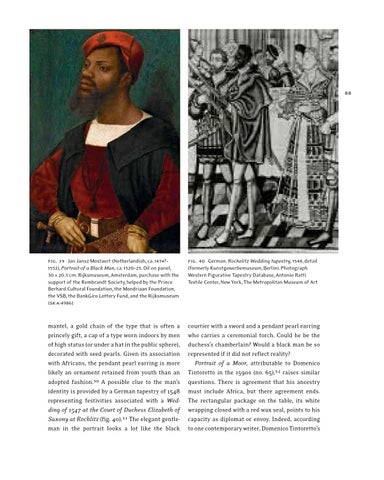88
fig. 39 Jan Jansz Mostaert (Netherlandish, ca. 1474?– 1552), Portrait of a Black Man, ca. 1520–25. Oil on panel, 30 × 20.3 cm. Rijksmuseum, Amsterdam, purchase with the support of the Rembrandt Society, helped by the Prince Berhard Cultural Foundation, the Mondriaan Foundation, the VSB, the BankGiro Lottery Fund, and the Rijksmuseum (sk-a-4986)
fig. 40 German. Rochelitz Wedding tapestry, 1548, detail (formerly Kunstgewerbemuseum, Berlin). Photograph Western Figurative Tapestry Database, Antonio Ratti Textile Center, New York, The Metropolitan Museum of Art
mantel, a gold chain of the type that is often a princely gift, a cap of a type worn indoors by men of high status (or under a hat in the public sphere), decorated with seed pearls. Given its association with Africans, the pendant pearl earring is more likely an ornament retained from youth than an adopted fashion.50 A possible clue to the man’s identity is provided by a German tapestry of 1548 representing festivities associated with a Wedding of 1547 at the Court of Duchess Elizabeth of Saxony at Rochlitz (fig. 40).51 The elegant gentle man in the portrait looks a lot like the black
courtier with a sword and a pendant pearl earring who carries a ceremonial torch. Could he be the duchess’s chamberlain? Would a black man be so represented if it did not reflect reality? Portrait of a Moor, attributable to Domenico Tintoretto in the 1590s (no. 65),52 raises similar questions. There is agreement that his ancestry must include Africa, but there agreement ends. The rectangular package on the table, its white wrapping closed with a red wax seal, points to his capacity as diplomat or envoy. Indeed, according to one contemporary writer, Domenico Tintoretto’s
